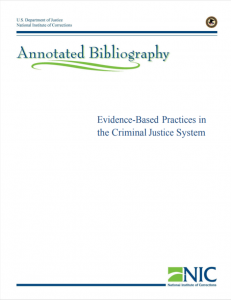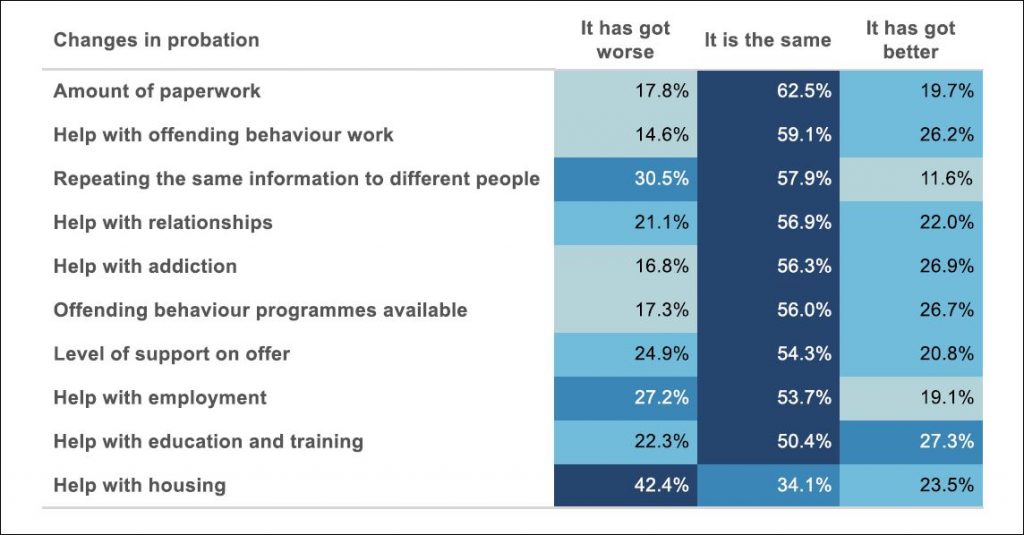The Real-World Application of the Risk Principle: Is It Possible in the Field of Probation?
Scott W. VanBenschoten, John Bentley, Nancy Beatty Gregoire, Christopher T. Lowenkamp
Although the concepts of the Risk, Needs, and Responsivity Model (Andrews and Bonta) seem simple, their practical implementation remains a challenge in agencies around the world. In this article the authors take one concept of this model, the Risk Principle, and examine how it is currently applied in the federal system. The authors then suggest how the Risk Principle could evolve into a more practical and deliberate decision point in the supervision of persons on court-ordered supervision with the introduction of a violence assessment.
Using a Multi-level Risk Assessment to Inform Case Planning and Risk Management: Implications for Officers
Ralph C. Serin, Christopher T. Lowenkamp, James L. Johnson, Patricia Trevino
There is compelling evidence that the federal Post Conviction Risk Assessment (PCRA) has predictive accuracy such that clients with higher risk scores have poorer probation outcomes. Because the PCRA can predict client outcomes for both baseline and change scores, probation officers are better equipped to identify intervention strategies for individual clients. However, while the PCRA predicts client rearrests as well as informs case planning and risk management, this process is not completely intuitive for some officers. As such, the authors’ purpose in this article is to make the process more explicit, especially regarding violent rearrest.
Enhancing Community Supervision Through the Application of Dynamic Risk Assessment
Christopher T. Lowenkamp, James L. Johnson, Patricia Trevino, Ralph C. Serin
Increasingly experts in the risk assessment field have argued that accuracy regarding the timing of client outcome can be enhanced by considering changes in acute dynamic risk factors. The current research was undertaken to examine whether certain acute
dynamic risks might better identify not only which clients are at risk but also when that risk might be most elevated for a particular client, allowing officers to consider risk at the case level and intervene accordingly to mitigate risk.
How Dangerous Are They? An Analysis of Sex Offenders Under Federal Post-Conviction Supervision
Thomas H. Cohen, Michelle C. Spidell
Key questions about the federal sex offender population explored in this article are what are the most common offense types under post-conviction supervision, how many have an official arrest or conviction record of offline contact sexual behavior, what
are their general recidivism risk characteristics, and how frequently do these offenders reoffend or get revoked? The authors also discuss the federal judiciary’s policy for supervising sex offenders, briefly summarize prior research on federal sex offenders, and
present policy implications and directions for future research.
Imagining Sentinel Event Reviews in the U.S. Probation and Pretrial Services System
Janette Sheil, James Doyle, Christopher T. Lowenkamp
In normal operations, practical drift from policy and procedures may go unnoticed, but in a critical high-profile situation any deviation from policy will be scrutinized. Conducting system-wide reviews can help uncover practical drift at all levels of an organization. The authors ask whether the federal criminal justice system can develop this capacity for “forward-looking accountability,” accepting error as an inevitable element of the human condition, studying known errors in a disciplined and consistent way, sharing the lessons learned to prevent future errors, and focusing on future risks rather than on blame for the past.
False Positives, False Negatives, and False Analyses: A Rejoinder to “Machine Bias: There’s Software Used Across the Country to Predict Future Criminals. And It’s Biased Against Blacks.”
Anthony W. Flores, Kristin Bechtel, Christopher T. Lowenkamp
The authors respond to a recent ProPublica article claiming that the widely used risk assessment tool COMPAS is biased against black defendants. They conclude that ProPublica’s report was based on faulty statistics and data analysis and failed to show that the COMPAS itself is racially biased, let alone that other risk instruments are biased.
Communicating Risk Information at Criminal Sentencing: An Experimental Analysis
R. Barry Ruback, Cynthia A. Kempinen, Leigh A. Tinik, Lauren K. Knoth
This experimental study examined whether actuarial risk information affects decision makers’ judgments about recidivism risk, whether the type of presentation makes a difference in judged risk, and whether there are differences in judged risk depending on type of crime. In the study, participants (judges, attorneys, and probation officers in four counties of Pennsylvania) received the actuarial risk score of six offenders in one of three formats, along with the meaning of that score in terms of risk of rearrest within three years. Participants then rated recidivism risk before and after receiving the information. Results indicated that the actuarial risk information significantly reduced risk judgments.
Examining Changes in Offender Risk Characteristics and Recidivism Outcomes: A Research Summary
Thomas H. Cohen, Christopher T. Lowenkamp, Scott W. VanBenschoten
This study found that many federal offenders initially classified at the highest risk levels moved to a lower risk category in their second assessment and that offenders tended to improve the most in the PCRA risk domains of employment and substance abuse. In addition, high, moderate, and low-moderate risk offenders with decreases in either their risk characteristics or overall risk assessment scores were less likely to recidivate than their counterparts whose risk levels or scores remained unchanged or increased. Conversely, increases in offender risk were associated with higher rates of arrests.



 L’une des principales difficultés que doivent surmonter les organismes correctionnels de la collectivité est de trouver une façon d’appliquer les connaissances acquises sur les approches efficaces à leurs pratiques quotidiennes. Le respect des principes du risque, des besoins et de la réceptivité en matière de prestation de services est menacé par diverses questions liées à la conception, à la mise en oeuvre et à l’évaluation des programmes dont il faut tenir compte dans le « monde réel » de la surveillance communautaire. L’Initiative de formation stratégique en surveillance communautaire (IFSSC), qui a été élaborée à titre de modèle de prestation de services et de programme de formation sur sa mise en oeuvre, visait à aider les agents de probation à appliquer ces principes à leurs pratiques régulières de surveillance. Dans le présent rapport, nous décrivons les difficultés et les problèmes dont il faut tenir compte quand vient le temps d’appliquer le résultat des recherches au monde réel de la surveillance communautaire dans lequel vivent les agents de probation et nous évaluons les efforts qui ont été déployés pour surmonter ces difficultés dans le cadre de l’IFSSC. Fermement enraciné dans les principes du risque, des besoins et de la réceptivité, le modèle de surveillance proposé dans l’IFSSC met l’accent sur les interventions des agents qui visent à faciliter les changements prosociaux d’attitudes et de cognitions chez les délinquants qui présentent un risque de récidive qui va de modéré à élevé. Pour assurer l’intégrité des services et le maintien des compétences des agents de probation, l’IFSSC permet non seulement à ces derniers de suivre une formation initiale de trois jours portant sur le modèle et les interventions cognitivo-comportementales de base, mais elle offre également une surveillance clinique continue. L’affectation aléatoire des cas des délinquants aux agents de probation et l’observation directe de leurs interactions avec les délinquants sont les composantes clés de l’évaluation de cette initiative. Les résultats préliminaires révèlent que l’IFSSC a eu une incidence considérable sur l’amélioration de la capacité des agents de probation à utiliser les pratiques correctionnelles de base efficaces.
L’une des principales difficultés que doivent surmonter les organismes correctionnels de la collectivité est de trouver une façon d’appliquer les connaissances acquises sur les approches efficaces à leurs pratiques quotidiennes. Le respect des principes du risque, des besoins et de la réceptivité en matière de prestation de services est menacé par diverses questions liées à la conception, à la mise en oeuvre et à l’évaluation des programmes dont il faut tenir compte dans le « monde réel » de la surveillance communautaire. L’Initiative de formation stratégique en surveillance communautaire (IFSSC), qui a été élaborée à titre de modèle de prestation de services et de programme de formation sur sa mise en oeuvre, visait à aider les agents de probation à appliquer ces principes à leurs pratiques régulières de surveillance. Dans le présent rapport, nous décrivons les difficultés et les problèmes dont il faut tenir compte quand vient le temps d’appliquer le résultat des recherches au monde réel de la surveillance communautaire dans lequel vivent les agents de probation et nous évaluons les efforts qui ont été déployés pour surmonter ces difficultés dans le cadre de l’IFSSC. Fermement enraciné dans les principes du risque, des besoins et de la réceptivité, le modèle de surveillance proposé dans l’IFSSC met l’accent sur les interventions des agents qui visent à faciliter les changements prosociaux d’attitudes et de cognitions chez les délinquants qui présentent un risque de récidive qui va de modéré à élevé. Pour assurer l’intégrité des services et le maintien des compétences des agents de probation, l’IFSSC permet non seulement à ces derniers de suivre une formation initiale de trois jours portant sur le modèle et les interventions cognitivo-comportementales de base, mais elle offre également une surveillance clinique continue. L’affectation aléatoire des cas des délinquants aux agents de probation et l’observation directe de leurs interactions avec les délinquants sont les composantes clés de l’évaluation de cette initiative. Les résultats préliminaires révèlent que l’IFSSC a eu une incidence considérable sur l’amélioration de la capacité des agents de probation à utiliser les pratiques correctionnelles de base efficaces.